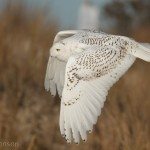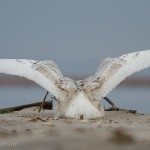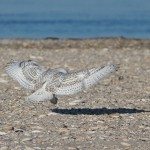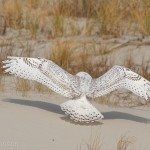Have you seen or photographed a Snowy Owl?
You can help us understand the extent and nature of their irruptions, just submit your sighting to eBird, and upload your photograph of Snowy Owls with open wings and tails.
Digital photography is making it possible to document Snowy Owl sightings and, in many cases, determine the age and sex of the owl. We’re trying to harness the army of birders and photographers to help us better understand the distribution of snowy owls each winter.
Ageing and sexing Snowy Owls is considerably harder than most birders think, complicated by broad overlap between the sexes in degree of marking, as well as fading. But with good, clear photographs it can be possible in many cases, especially if the photo shows a spread wing and/or tail. Perched photos are less useful for this, because they don’t show sex-specific patterns on the secondary wing feathers and tail that can allow young snowy owls to be sexed.
Please submit your photographs with your eBird checklists, where sightings can be used by scientists for questions beyond the scope of this project as well. By submitting your photographs with eBird checklists, Snowy Owl experts will be able to classify reported owls by age and sex, giving us a better sense of where and when each class of snowy owls is found during winter. An eBird account is free and you can embed your photos in the checklist.
Submit sightings to eBird
Details
- Location: Choose the location for your eBird checklist as accurately as possible, picking the area where the owl was seen.
- Include comments about the sighting, including whether there are other Snowy Owls in the area, and any interactions you might see.
PLEASE DO NOT FLUSH a perched owl for flight photographs. With patience, especially late in the day, most snowy owls will move on their own. Respect the birds and their space.
Project SNOWstorm will not make commercial use of your photographs, period.
- Spread wing can be used to age or sex an owl. (© Tom Johnson)
- Spread wing and tail age this owl as an immature male based on the molt limits (© Tom Johnson)
- (© Tom Johnson)
- Sitting birds provide very little detail for us to be able to age or determine the sex of the owls. (© Allen Sklar)
- Photos showing upperside of tail are particularly helpful. (© Tom Johnson)
Ageing snowy owls: The only accurate way to differentiate young snowies from adults is by looking for what banders call “molt limits,” contrasts between older, more faded flight feathers, and newer, more blackly marked feathers. This can be subtle, and often requires a trained eye. The degree of barring and marking may decrease with age, as most birders assume, but may also remain the same or even darken — there is a great deal of variability.
Sexing snowy owls: Most birders assume that male snowies are whiter than females, and that is generally true. But the overlap in markings between the sexes is great and confusing. In first-year owls, females have more bars than spots on the middle secondaries, where males have more spots than bars. Female snowies generally have three or more bars on the tail, while males generally have three or fewer, although this is not diagnostic. The terminal dark tail band generally extends from edge to edge on females, but stops short of the edge of the feather in males.
Click here to submit photos
References:
Bortolotti, G.R. and M. Stoffel. 2012. The coloration of snowy owls is not black and white. In The Snowy Owl, E. Potapov and R. Sales. 2012. London: T & A.D. Poyser.
Josephson, B. 1980. Aging and sexing snowy owls. Journal of Field Ornithology 51(2):149-160.
Seidensticker, M.T., D.W. Holt, J. Detienne, S. Talbot and K. Gray. 2011. Sexing young snowy owls. Journal of Raptor Research 45(4):281-289.
Solheim, R. 2012. Wing feather moult and age determination of snowy owls Bubo scandiacus. Ornis Norvegica 35:48-67.






